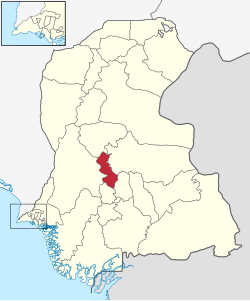Top Qs
Timeline
Chat
Perspective
Matiari District
District of Sindh in Pakistan From Wikipedia, the free encyclopedia
Remove ads
Matiari District (Sindhi: ضلعو مٽیاري, Urdu: ضلع مٹیاری) is a district in the Pakistani province of Sindh. Located on the left bank of the Indus River, Matiari became an independent district on 30 May 2004 during the military regime of Pervez Musharraf, when Hyderabad was divided into four districts — Tando Allahyar, Matiari, Tando Mohammad Khan and Hyderabad.[3]
This article needs additional citations for verification. (May 2021) |
Remove ads
Etymology
The word Matiari is derived from two Sindhi words Mat and yari, which means friendship with earthen water pots.
According to culture, the Main Bus Stop at Matiari Main Road was where a lady sat in a hut a long time ago. It is where she kept an earthen pot of water. People of Matiari would tell the bus conductor to stop at "Mat Wari Maai" (old woman's hut where she keeps earthen pot of water). This is apparently why it the district is called Matiari.
Remove ads
History and administration
Matiari district was carved out of Hyderabad district along with Tando Allahyar and Tando Muhammad Khan districts in 2005.[4] Matiari district is part of the Hyderabad division. The district is administratively subdivided into three talukas:[5]
There are 30 union councils in the district as tabulated below:[6]
Remove ads
Demography
Summarize
Perspective
As of the 2023 census, Matiari district has 158,463 households and a population of 849,383.[8] The district has a sex ratio of 102.58 males to 100 females and a literacy rate of 45.88%: 56.34% for males and 35.12% for females.[1][9] 266,740 (31.41% of the surveyed population) are under 10 years of age.[10] 202,673 (23.86%) live in urban areas.[1]
The majority religion is Islam, with 81.67% of the population. Hinduism (including those from Scheduled Castes) is 18.03% of the population. Members of other religions are largely Christians.[11]
At the time of the 2023 census, 92.95% of the population spoke Sindhi, 2.66% Urdu, 1.33% Balochi and 1.31% Hindko as their first language.[14]
Remove ads
Notable places
The shrines of Pir Rukun-Din-Shah, Makhdoom Sarwar Nooh, Shah Abdul Latif Bhittai, Sakhi Hashim Shah pir Haider shah, Muhammad Faquir Khatian and others are located in Matiari district. Miani forest and the battleground of Sir Charles Napier and Talpur rulers of Sindh and Miani jo Maidan are also situated in Matiari district.
Syed Rukun-Din-Shah also fought a battle with the Arguns dynasty with seven bilalis of sindh.
At Khuda aabad, one can find the graves and the tombs of Mughal Empires era. There is a Masjid (Praying Place) and a well of water.
The Indus River is also there.
Remove ads
Agriculture
Matiari district is one of the most fertile districts of Sindh. The main crops cultivated are cotton, banana, mango, wheat, onions and sugarcane.
Politics
The elected representatives from Matiari district are
- MNA Makhdoom Jameel-uz-Zaman (PPPP) NA 223
- MPA Makhdoom Mehboob Zaman (PPPP) PS 58
- MPA Makhdoom Rafique Zaman (PPPP) PS 59
List of union councils
The following is a list of Matiari District's union councils, organised by Tehsils:[15]
- Hala Tehsil (35 Dehs)
- Matiari Tehsil (49 Dehs)
- Abrejani
- Arain
- Barechani
- Baudero
- Bhanoki
- Bhorko
- Buhryoon
- Chharao
- Dhando
- Ganag Rayati
- Gang Jagir
- Hakra
- Jaheki
- Kaindal Kot
- Jakhri Jagir
- Jakhri Joya
- Jakhri Rayati
- Ketti
- Khorkhani
- Khudi
- Khyberani
- Koheki
- Lutryoon
- Mari
- Matiari
- Mubarak Wah
- Nindero
- Oderolal
- Palijani
- Panhwarki
- Pano
- Porath
- Reechal
- Sadri
- Saeedpur
- Sahib Saman
- Sattar
- Sekhat
- Shahpur
- Sipki Jagir
- Sipki Rayati
- Sohiki
- Soomra
- Sultanpur
- Tajpur
- Thano
- Thorha
- Vesro
- Wassan
- Saeedabad Tehsil (28 Dehs)
- Ahano
- Amin Lakho
- Bawri
- Chhachhri
- Chhapar Kahan
- Chitori
- Dalo Keti
- Dethki
- Fatehpur
- Gadali
- Giss
- Jamali
- Kaka
- Khatoori
- Khuteero
- Koonar
- Larh
- Manahi
- Odiyanoo
- Panjmoro
- Peengharo Jagir
- Peengharo Raieti
- Rahoo
- Rahooki
- Ranoo
- Saeedabad
- Suhrabpur
- Zairpir
Remove ads
Notes
- Including Jainism, Christianity, Buddhism, Zoroastrianism, Judaism, Ad-Dharmis, or not stated
References
Bibliography
External links
Wikiwand - on
Seamless Wikipedia browsing. On steroids.
Remove ads


